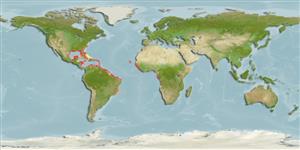Environment: milieu / climate zone / depth range / distribution range
Ecologia
marinhas demersal; intervalo de profundidade 21 - 70 m (Ref. 2683), usually ? - 50 m (Ref. 26999). Subtropical; - 25°S
Western Atlantic: Bermuda and southern Florida, USA to Brazil. Lesser Antilles (Ref. 26938). Eastern Atlantic: Senegal to Angola (Ref. 4455). Doubtful record from the western Mediterranean (Ref. 13729).
Tamanho / Peso / Idade
Maturity: Lm ? range ? - ? cm
Max length : 210 cm TL macho/indeterminado; (Ref. 26938); common length : 100.0 cm TL macho/indeterminado; (Ref. 5217)
Body pale, dark band across back of head (Ref. 26938).
Maximum depth from Ref. 126840. Lives in a permanent burrow, often in very shallow water. Heads protrude diagonally from the sand. Nocturnal. Feeds on octopus and fish (Ref. 5217). Bold and easily approached. Feared by fishers (Ref. 9710). Rarely consumed (Ref. 3795).
Ciclo de vida ou comportamento de acasalamento
Maturities | Reprodução | Spawnings | Egg(s) | Fecundities | Larvas
Böhlke, J.E., 1981. Ophichthidae. In W. Fischer, G. Bianchi and W.B. Scott (eds.) FAO species identification sheets for fishery purposes. Eastern Central Atlantic, (Fishing Areas 34, 47 (in part)), Vol. 3, [var. pag.]. FAO, Rome. (Ref. 3651)
Status na Lista Vermelha da UICN (Ref. 130435)
Ameaça para os humanos
Reports of ciguatera poisoning (Ref. 30911)
Uso pelos humanos
Pescarias: sem interesse; isca: usually
Ferramentas
Relatórios especiais
Baixar XML
Fontes da internet
Estimates based on models
Preferred temperature (Ref.
123201): 19.2 - 27.5, mean 24.8 °C (based on 156 cells).
Índice de diversidade filogenética (Ref.
82804): PD
50 = 0.5000 [Uniqueness, from 0.5 = low to 2.0 = high].
Bayesian length-weight: a=0.00089 (0.00039 - 0.00204), b=3.00 (2.80 - 3.20), in cm total length, based on LWR estimates for this (Sub)family-body shape (Ref.
93245).
Nível Trófico (Ref.
69278): 4.5 ±0.80 se; based on food items.
Resiliência (Ref.
120179): Muito baixo(a), tempo mínimo de duplicação da população maior que 14 anos (Preliminary K or Fecundity.).
Fishing Vulnerability (Ref.
59153): Very high vulnerability (90 of 100).
